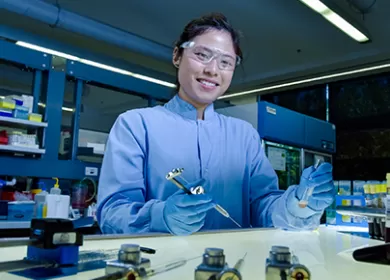Don’t have an account?
Select the donation type you’d like to make
Platelets under the microscope
I am interested in how platelets, the smallest blood cells, function. Platelets are important to prevent bleeding, and a transfusion of platelets can be life-saving for patients with cancer or those who are having surgery. However, we are now beginning to understand that platelets from different donors can behave differently. At the Australian Red Cross Lifeblood, my research is helping us to find out how in the future we could choose the best platelet for every patient.
How we collect and store platelets
Platelets form clots to keep us from bleeding, but this life-saving ability is also their weak point. To stop them clotting and keep them alive during storage, blood banks need to store platelets with constant agitation at room temperature. This means they have a short shelf-life of only 7 days, which in turn makes it difficult to keep up supplies.
Lifeblood collects platelets two different ways. The first takes the whole blood collected through a regular blood donation and separates the platelets from whole blood, a process you can see in this video. The second way is through a donation process known as plateletpheresis and uses a machine to extract platelets from the blood during the donation process and then returns the rest of the blood back to the donor.
In Australia, we prepare most of our platelets from whole blood. We combine platelets from four donors who have identical blood groups. The platelets are stored in a solution containing donor plasma and a combination of substances to feed and preserve them.
If a donor has taken aspirin or similar medicines in the seven days before a donation, it can interfere with the function of their platelets. This is one reason we ask about which medicines our donors have taken recently.
Not all platelets are equal
Scientists have found that some platelets work better after transfusion than others. The difference could lie in the donor’s genetic background, or their diet, health or medicines that they have taken. Platelet function may also be affected by how they are processed and stored, including temperatures, transport and agitation.
My research is helping us understand the behaviour of platelets.
Normally, platelets circulate in the blood in a resting state. When they are called into action to prevent bleeding, they need to bind to an injury site and eventually form a stable clot. Complex chemical signals in the body control the balance between circulating and clotting. When this balance is disturbed, platelets may be too active, which can in turn trigger uncontrolled blood clot formation (thrombosis) leading to life-threatening cardiovascular diseases.
Platelets from different donors respond differently to chemical signals. Those that are easily activated would be ideal for stopping bleeding in emergencies. On the other hand, less reactive platelets may be better for cardiovascular patients because these patients are more prone to thrombosis.
I am trying to find the perfect platelet donor with to help us select the right donor for the right patient.


